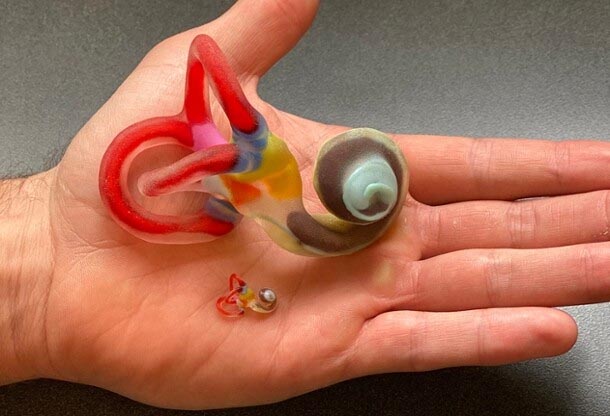
Sponsored by Johns Hopkins Medicine, Penn State biomedical engineering and mechanical engineering students partnered to analyze the Bast valve (a life-size and an enlarged 3D-printed model are shown here) and any possible relationships with Ménière’s Disease, which is thought to contribute to vertigo and tinnitus among other disorders. IMAGE: PROVIDED.
Student research sheds new light on inner ear disease
A team of undergraduate engineering students create the first computational model of the Bast valve located inside the inner ear, suggesting a previously unknown role in Meniere's disease
6/21/2021
By Erin Cassidy Hendrick
UNIVERSITY PARK, Pa. — The function and purpose of the Bast valve, a thin membrane in the inner ear, has largely been a mystery to medical professionals since it was discovered more than 100 years ago. However, research conducted by a team of undergraduate students in the Penn State College of Engineering may be the catalyst to understanding the valve and ultimately treating a debilitating inner ear disease.
“We are able to work on this project that’s groundbreaking,” said Stephanie Tang, a former biomedical engineering undergraduate student. “No one has ever modeled the Bast valve before and we were able to confirm it is a pressure valve and could play a role in Ménière’s disease, which is a completely new finding.”
After modeling the valve as part of their senior capstone design course, then-engineering students and now alumni Tang, Diana Lowther, Rhys Butler, Ethan Neuwirth Guerra, Daniel Ford, Mark Latuska, Andrew Paulauskas and Tacie Telesky have been asked to present their findings to renowned specialists at Johns Hopkins Medicine. The team also expects to publish their results in a peer-reviewed journal.
“In addition to demonstrating the Bast valve likely functions as a valve, the team demonstrated that the flow is most likely unidirectional,” said Dr. Bryan Ward at Johns Hopkins, the project’s sponsor. “They also generated new, testable hypotheses for how the valve opens and can be affected by disease. These will be significant contributions to the medical literature.”
The Bast valve, only one cell-layer thick and roughly the size of a grain of salt, is shaped like a fish’s mouth and sits between chambers of the inner ear in many animals, including humans.
It is suspected to be a factor in triggering Ménière’s disease, an inner ear syndrome that is caused by a pressure buildup and can cause vertigo, tinnitus and hearing loss. Ward explained these symptoms can significantly impair a person’s quality of life. Physicians currently theorize the Bast valve helps with pressure regulation and when it malfunctions, patients can experience Ménière’s.
However, there wasn’t much data-driven knowledge available about the valve, until the students presented their work during the spring 2021 Learning Factory Capstone Design Project Showcase.
Richard Kinard, the project’s industry adviser, felt personally connected to the project not only because he is a 1973 Penn State biomedical engineering alumnus and a member of the Department of Biomedical Engineering’s Industrial and Professional Advisory Council — he also suffers from Ménière’s disease. After receiving a diagnosis from Ward, Kinard pitched the idea of a Penn State student capstone engineering project sponsored by the Johns Hopkins Medicine Division of Otology and Neurotology.
“I was confident Dr. Ward would suggest a related medical mystery for Penn State seniors to solve,” Kinard said. “Wouldn’t you be challenged to solve a hundred-year-old medical mystery by taking a fresh, science and engineering-based approach?”
The student engineers created mathematical and computational models based on human anatomical data to observe the valve under healthy and diseased conditions. They were able to demonstrate the valve opening and closing in response to pressure changes.
The team worked to overcome several challenges while investigating the valve. The current research is limited due to its microscale size, lack of data on the material properties of the valve’s tissue, ability to study living patients, and the expensive and time-consuming methods needed to gather high-resolution imagery on the valve.
“The fluid dynamics that occur within inner ears are difficult for physicians to study by themselves,” Tang said. “As engineers, we learned a lot of the computational modeling and process and then we’re able to think creatively of using those models to understand what is happening physiologically.”
Ward explained the outcomes of this project have sparked a new interest in the Bast valve.
“At the start of this project, the valve was a curiosity to me,” he said. “The students have motivated me and my colleagues to investigate the role of this valve in health and disease. Because these findings are so interesting, the work the students have done this semester is affecting the trajectory of research.”
As a team comprised of budding biomedical and mechanical engineers, the students had the perspective and skill set to design, test and communicate the outcomes of this project.
“Although the medical and biomedical engineering fields are related, the approaches are very different,” Lowther said. “It was awesome to see our sponsors from Johns Hopkins come in with the medical perspective and us as engineers create a numerical point of view.”
Work on this project will continue with a new cohort of engineering students, who hope to discover more about this mysterious valve and its impact on Ménière’s disease by building a 3D model.
Looking to the future, Tang and Lowther are excited to use their skills as biomedical engineers to enhance people’s lives.
“The collaboration between engineers and physicians will help promote a better understanding of not only this disease but also better health care overall,” Tang said.



